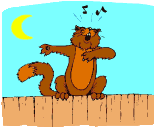Mousekateers
Articles
|
|
This infundibulum, as it is called, is connected to the hypothalamus. One function of the hypothalamus is to feel and interpret emotions. It determines if a certain sensory stimulus is pleasant, like being petted, or painful.
Purring Felines: Pain or ecstasy? The feline "purr center" is located in an area of the brain near the hypothalamus called the infundibulum. This was discovered back in 1936 by two Harvard University researchers, E. L. Gibson, and F. A. Gibbs that probably had way too much time on their hands! When I read about this study I can envision a cat in an operating room with it's brain being given a little electrical stimulus here, then there, until they finally found the magic spot that produced purring. This doesn't paint a very pretty picture, but we humans are very curious. Maybe this is where the saying really comes from that curiosity killed the cat! Nonetheless, they did discover the "purr center" in the cat's brain.
The interesting thing about the hypothalamus is that it releases endorphins, which are morphine-like substances, that stimulate the "purr center" causing that wonderful, vibrating purr that we are all so familiar with.
A cat's body, like humans, is an intricate and beautifully designed series of checks and balances. Pain stimulates the hypothalamus to release it's endorphins as a natural-like endogenous morphine that helps block the pain. The release of these endorphins also stimulate the "purr center" in the cats brain and cause it to purr.
This is why a cat that is injured or sick, or a queen in labor, may also purr.
References: "A Purring Center in the Cat's Brain," (Journal of Comparative Neurology, 64:6, 1936)


Purr-fect Vibrations or Purr-fect Pitch?
Kittens, born blind and deaf, purr in response to their mother licking them. Their mother purrs so that they can find her, and purring acts to comfort both of them.
If you've ever observed a queen with her litter of kittens, you may have noticed the kittens purring as they nurse. Kittens can purr with their mother's nipple in their mouth, and cats can purr with their mouths tightly closed. This phenominum of suckling and purring at the same time can occur because purring is not a vocal sound. It does not come from the true vocal cords. Cats can purr as they take a breath in, or as they breathe out.
No one really knows for sure where the sound comes from but there are several theories on this subject.
This first theory is called the diaphragm-larynx theory which maintains that the sound is based on positive pressure in the lungs causing the glottis to rapidly open and close which causes the vibrations that we hear as purring. A similar theory suggests that it's the vibrations of the false vocal cords, located right behind the true vocal cords, in the larynx that cause the sound.
A second theory is the soft-palate theory proposed by Dr. Richard Jakowski, associate professor of pathology at Tufts University School of Veterinary Medicine, who noted voluntary skeletal muscle fibers in the cat's elongated soft palate in the back of the throat. His theory is that a cat can voluntarily "flutter" its soft palate producing the purring sound.
A third, and less accepted theory, is the blood-turbulence theory. This theory suggests that the sound is produced by turbulence of blood flowing in the superior vena cava vein that is attached to the heart. It is thought that this turbulence occurs when this large vein constricts, or is compressed by the cat when it arches its back.
Referrences:
J. E. Remmers, H. Gautier, "Neural and Mechanical Mechanisms of Feline Purring," 16 Respiration Physiology 1972
Catnip, Tufts University School of Veterinary Medicine, Vol 1, No 9. December, 1993
|
Angela Bassett Benny Billi Cameron Diaz Chipmunk Christina Ricci Halle Berry Honey Jennifer Lopez Lassie Cheyenne Laurel Lindsay Lohen Peggy Sue Reba McIntire Tyra Banks Vanessa Williams Wooly Bully |

Want to listen to some music? Just point and click. It takes a second to load, so please be patient. Music
|

